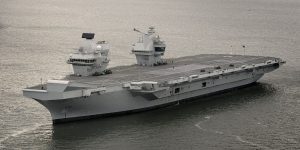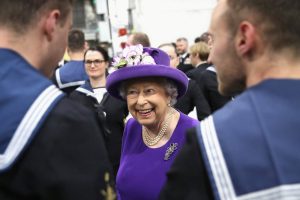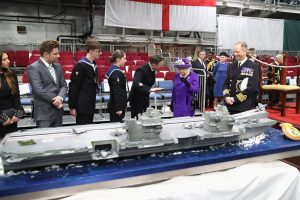2017-12-082017-11-20 The new Queen Elizabeth class carrier is the largest warship ever built in the United Kingdom.
While most of the focus of the press coverage has been on the process of building the carrier and now its sea trials, the carrier is coming at a very interesting point in British history.
There is a clear need to shape a post-Brexit defense policy, and having a significant epicenter of national sovereignty able to operate throughout the region and beyond certainly can be worked into that as yet to be written policy narrative.
HMS Queen Elizabeth is currently on sea trials off the south coast of England.. Credit: UK Ministry of Defence
This narrative has begun to be written and was articulated as follows by the new defense minister in his visit onboard the ship earlier this month:
“This is very much about how Britain can project its influence and its power right across the world,” Mr. Williamson said.
“It is how we can say to the rest of the world, we are not a nation in retreat, we are a nation that wishes to play a significant part in world affairs.”
But it also also at the heart of integrating UK forces to deliver UK capabilities within the integrated battlespace, both in terms of an integrated carrier strike force as well as in terms of shaping the various war fighting systems which will come together onboard the ship.
It is however at the heart of shaping 21st century interoperability.
There is the interoperability being worked with the US Navy, as evidenced in the recent Saxon Warrior exercise off of Scotland.
There is the interoperability being worked as the USMC will operate its F-35Bs off of the ship.

This will require an ability for the ship to operate US weapons onboard as well as to accommodate USMC maintainers as well with their specific national maintenance approaches.
The ship is an F-35 carrier and will work its interoperability with other F-35s as well in the region, notably with the Dutch, the Norwegians, the Danes, the Italians, the Israelis, the US and perhaps others Europeans as well.
In other words, the carrier is at the vortex of a turn in British history, and a key element of shaping 21st century force integration and interoperability.
The Queen Elizabeth carriers have been built an innovative industrial consortium in which at the height of construction on any one day 12,500 workers were working on the carrier but of those only 2,500 we working in the actual shipyard.
According to an article published on the UK Ministry of Defence website, the HMS Queen Elizabeth was commissioned on December 7, 2017.
The Queen spoke at a ceremony in Portsmouth’s naval base this morning, attended by Her Royal Highness Princess Anne, Defence Secretary Gavin Williamson, Chancellor Philip Hammond and military chiefs.
In her role as the ship’s Lady Sponsor Her Majesty addressed guests before the Ship’s Commanding Officer, Captain Jerry Kyd, read the commissioning warrant. The iconic White Ensign was then raised, symbolising the commissioning of the nation’s future flagship into the Royal Navy’s fleet.
Defence Secretary Gavin Williamson said:
“Today marks the start of a hugely significant chapter for the Royal Navy, and indeed the nation, as the future flagship is commissioned into Her Majesty’s fleet. It is an honour to witness the crowning moment of an extraordinarily busy year for the Royal Navy that has seen us name the second carrier, HMS Prince of Wales, cut steel on the first Type 26 frigates and launch the National Shipbuilding Strategy.
“Our new aircraft carrier is the epitome of British design and dexterity, at the core of our efforts to build an Armed Forces fit for the future. For the next half a century both carriers will advance our interests around the globe, providing the most visible symbol of our intent and commitment to protect the UK from intensifying threats, wherever they may come from.”

Having successfully completed her second stage of sea trials off the south coast of England, the carrier is back alongside at her home port of Portsmouth. Over 10,000 people across the UK have contributed to the delivery of the ship under the Aircraft Carrier Alliance.
Completing final build activity and preparing for helicopter trials in the New Year, HMS Queen Elizabeth will head to the United States for initial flight trials off the coast in autumn 2018. There are currently 150 Royal Navy and RAF personnel training in the US on our 13 F-35 jets.
The UK has worked closely on both the F-35 and carrier programmes with the US, our pre-eminent partner within NATO, enabling us to fly aircraft from each other’s ships. Both of the UK’s new carriers will be able to operate alongside NATO and coalition allies.
Admiral Sir Philip Jones, First Sea Lord and Chief of Naval Staff, said:
“In hoisting the White Ensign from HMS Queen Elizabeth today, Britain has confirmed her place among the world’s great maritime powers in the most majestic and muscular terms.
“The Queen Elizabeth-class carriers will sit at the heart of a modernised and emboldened Royal Navy, capable of projecting power and influence at sea, in the air, over the land and in cyberspace, and offering our nation military and political choice in an uncertain world.
“But our greatest strength of all is the young sailors and marines upon whose shoulders our continued security and prosperity rests. They are starting their careers as a new chapter opens for the Royal Navy – and like all those who have gone before them, they are ready to serve their Queen and Country.”
Both new aircraft carriers will be able to perform a wide range of tasks, from humanitarian and disaster relief to fighting terrorism and high-end warfighting. In what has been termed, ‘the Year of the Royal Navy’ the second carrier, HMS Prince of Wales, was named in Rosyth and is structurally complete.
This year the Royal Navy has also had steel cut on the first of the Type 26 frigates and Dreadnought submarines, the launch of the National Shipbuilding Strategy, provisioning for a new class of frigate, the Type 31e, float out of the fourth Astute submarine, HMS Audacious, the naming of two Offshore Patrol Vessels and the arrival of our first two MARS Tankers in the UK.
Last month the Defence Secretary visited HMS Queen Elizabeth for the first time while at sea, meeting the crew and thanking them for their work towards UK defence.
Chief of the Air Staff, Air Chief Marshal Sir Stephen Hillier, said:
“Congratulations from the Royal Air Force to the Royal Navy on achieving another important milestone in the UK’s Carrier Strike capability. I know the RAF and RN F-35 crews are looking forward to starting to fly from HMS Queen Elizabeth next year.”
https://www.gov.uk/government/news/queen-welcomes-royal-navys-largest-ever-ship-into-the-fleet
And an article published on the UK MoD website on December 2, 2017 focused on the industrial contribution to building the new carrier class:
HMS Queen Elizabeth, the nation’s future flagship and the first of Britain’s two new 65,000 tonne aircraft carriers, will be formally commissioned into the Royal Navy by Her Majesty the Queen next week (07/12).
But the construction of the 280 metre-long ship would never have been possible without the essential work undertaken by small and medium sized enterprises (SME) from around Britain.
Defence Minister Harriett Baldwin said:
“On behalf of Defence, the government and the whole of the United Kingdom, I would like to thank the hundreds of businesses around the country for the millions of hours they’ve spent equipping our ships in what has been an immense nationwide enterprise.
“Their Herculean efforts showcase our great British talent and saw HMS Queen Elizabeth complete her 2017 sea trials with flying colours as she prepares to project our interests right across the world.”
Over 700 British SME’s have supported the build of the aircraft carriers in what has been a truly national endeavour. The programme has brought together the best of British industry, with construction involving more than 10,000 people including more than 800 apprentices.

Chief of Materiel Ships at the MOD’s Defence Equipment and Support organisation, Sir Simon Bollom said:
“I am incredibly proud of how DE&S and our colleagues across Defence have worked in collaboration with businesses across the UK to deliver a programme of such global significance.
“The success of the Queen Elizabeth class is a testament to the thousands of people who have worked on the programme and the vital skills they bring. I look forward to continuing our important relationship with industry to bring the second ship, HMS Prince of Wales, into service.”
In 2015/2016 the Ministry of Defence invested over £18bn with UK industry, supporting more than 120,000 full-time jobs, and benefiting local economies.
Last year saw the MOD’s direct spend with SME’s increase by over 10% across the country as it continues to make it easier for them to win defence business.
Defence Minister Harriett Baldwin has launched initiatives such as a new Supplier Portal, which brings together a range of useful information for new and prospective suppliers in one place for the first time, a dedicated Twitter account to flag opportunities to SMEs and simplified contracts for lower-value, less complex procurements.
Soon after the commissioning ceremony on Thursday 7th December, work will continue apace to ready Britain’s most advanced military vessel ever for the vital role it will play in projecting Britain’s influence around the world.
Next year the new F-35B Lightning II stealth jets, the most advanced warplane in the world, will start flight trials from the ship, and HMS Queen Elizabeth is on track to be fully deployable anywhere in the world by 2021.
Both of the UK’s aircraft carriers are being delivered by the Aircraft Carrier Alliance, a unique partnering relationship between industry and the UK Ministry of Defence.
https://www.gov.uk/government/news/business-contribution-to-britains-biggest-warships-recognised

